

![]()
SHEEPDOG TRIALS IN BRITAIN & IRELAND
"Without the shepherd's dog, the whole of the open mountainous land in Scotland would not be worth a sixpence. It would require more hands to manage a stock of sheep, gather them from the hills, force them into houses and folds, and drive them to markets, than the profits of the whole stock were capable of maintaining."
--James Hogg, 1824, from The Shepherd's Calendar
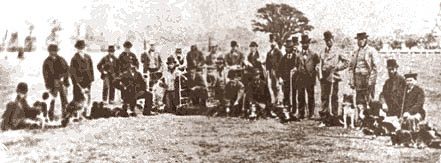
This wonderful old photograph is courtesy of Barbara Carpenter
of Pastors Hill House in Lydney, Gloucestershire, England,
who believes it to be of the competitors at the "First International"
sheepdog trials held at Alexandra Palace in London in June 1876.
However, the ISDS has this photo on their website and credit it as the "Muswell Hill Trials" in London, 1876.

Above, detail of a painting by O.Colley
THE BEGINNINGS
It is almost certain that there were sheepdog trials held in Britain as long as there have been agricultural shows, but the "earliest recorded" sheepdog trial took place at Bala, Wales, in 1873. According to Dr. Albion M. Urdank, Associate Professor of Modern British and European History at UCLA, and a sheepdog trialist himself,The Bala trial reproduced the traditional social hierarchy as a cultural event, and by doing so gave it a quality freighted with elite values and notions of what properly constituted the shepherds' craft. ("The Rationalization of Rural Sport: British Sheepdog Trials, 1873-1946" by Albion M. Urdank, Rural History, 2006, 17, 1, 65-82, Cambridge University Press.)
James A. Reid (secretary of the ISDS for 32 years from 1919-1946 and the man to whom the name "Border Collie" is attributed), gaves this account of early trials:
To Wales, in the person of the late Mr. J. Lloyd Price, of Rhiwlas, Bala, belongs the honour of originating sheep dog trials, the first trial being held at Bala on 9th October, 1873, when ten dogs competed before a gathering of two or three hundred people, the winner being a Scotsman, resident in Wales, with a Scotch-bred dog.... [I]n the following year (1874)...the second much improved Bala trials [took place] at which a cup was offered for competition. In 1875, 30 dogs were entered for the Bala trials at which the attendance rose to over 2,000; and further progress was made in 1876 and 1877, but in 1878 they were merged in , or superseded by, the Llangollen trials. As from their inception the Llangollen trials have been held annually (excepting during the war years, 1915-1918 and 1939-1945) under distinguished patronage, reaching their zenith in 1889 when Queen Victoria and other Royalty witnessed a private exhibition, sheep dog trials may be considered as permanently established in the Principality [of Wales] since 1874.
Before 1939 at least one hundred trials were held annually in Wales; today the number is legion, the trials being spread all over North and South Wales. From Wales the movement spread to England in 1876 and to Scotland about the sme time. Nowadays, sheep dog trials of one kind or another are popular all over the pastoral world, being held in hundreds and everywhere at home, occasionally in East Africa (Kenya), Canada, North America, South America (Falkland Islands) and especially in that paradise of the sheep dog, Australasia (New Zealand, Australia and Tasmania), in fact wherever the Collie is to be found as a flock guide. ("Sheepdog Trials" by J.A. Reid, The Book of the Dog by Brian Seymour Vesey-FitzGerald, Nicholson & Watson, 1948)
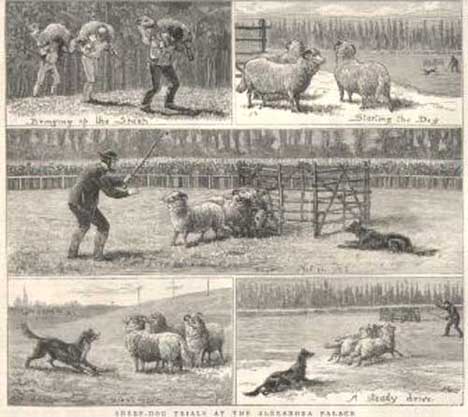 Right, the sheepdog trial at Alexandria Palace, London, that took place in June 1876, from a newpaper article of the time. We particularly enjoyed the picure at the top left, labeled "Bringing in the Sheep".
Right, the sheepdog trial at Alexandria Palace, London, that took place in June 1876, from a newpaper article of the time. We particularly enjoyed the picure at the top left, labeled "Bringing in the Sheep".
In 1973, the International Sheep Dog Society (ISDS) held a Centenary Trial at Bala to commemorate the anniversary of this "first recorded sheepdog trials in Britain", held on the very same spot 100 years before. The program of the commemorative trial, written in Welsh and English by Einion Thomas, gave the story of the historic first trial:
On the 9th of October 1873, a day that was noted for being wet and cold, the first recorded sheepdog trials in Britain were held on Garthgoch and Rhiwaedog fields. It was R. J. Lloyd Price of Rhiwlas who organised this first trial...
Although the weather was unfavourable about 300 spectators turned up to see the competition....
The competition was in two parts--(a) Penning: 'Entrance to the pen about 6ft. wide, situated about 500 yards from the fold.' (b) Driving: 'Sheep carried to the top of a grass field and turned out in full view, some 800 yards from where the shepherd and his dog, and the spectators were congregated.' The sheep were to be driven towards the shepherd. The time allowed was twenty minutes.
Even though the majority of the competitors were Welsh, the first prize went to a Scotchman, James Thompson with his dog Tweed...
Arising out of this trial ...was the first international trial in London. James Thompson after his victory had bragged about the superiority of Scottish shepherds and dogs. This hurt the pride of the local shepherds who issued a challenge, declaring that they would meet the Scots or shepherds from any other country to see who had the best dogs. R. J. Lloyd Price with a small committee set about organising the competition, and on the 30th of June 1876, under the auspices of the Kennel Club, trials were held at Alexandra Park in London ...The pride of the local shepherds was restored when John Thomas of Cwm yr Aethnen won the competition.
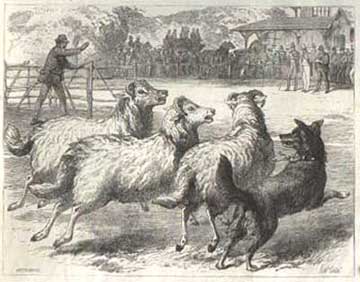 Right, another picture from the trials at Alexandria Palace.
Right, another picture from the trials at Alexandria Palace.
Eric Halsall says that although "a little hazy in accuracy of detail, the first trials to be held in Scotland were at Carnwath Agricultural Society's show on the fringe of the Pentland Hills in Lanarkshire in the early 1870s. They were won by a young Pentland shepherd, James Gardner, with Sly, a pretty little black and white bitch with a strong 'eye'." (Sheepdog Trials by Eric Halsall, Patrick Stephens, Cambridge, 1982)
"Two trials were held in England during 1876," says Barbara Carpenter,
The second trial held in England that year was held in Northumberland in the Borders in September. "Records are inconclusive as to the outcome," Eric Hallsall says:...The first one being [held] in a London park--Alexandra Palace--a couple of months before the other one, and was organised by Mr. Lloyd Price. Apparently it was not successful; many of the wild Welsh wethers, transported especially from Wales, escaped from the trial field and were never recovered. This event was not repeated.
Mr. Lloyd Price had organised the sheep for this trial, and no doubt their loss was his financial loss!
As he and Mr. Shirley were great friends, it was probably due to Mr. Shirley's involvement with the Kennel Club that this trial was 'under the auspices' of the K.C. [Shirley] founded the K.C. in 1873, the same year in which he was also involved with Mr. Price in organising the famous first official Welsh trial at Bala. (National Sheepdog Champions of Britain and Ireland, 1922-1993 by Mrs. E.B. Carpenter, Farming Press, Ipswich, 1994)
...Three possible winners [were mentioned], Walter Telfer with his old white dog...; John Robson ...with a beautiful bitch called Maddie; and Simon Rutherford's bearded collie from Blackburnhead. The course was a good hill test, dogs having to cross the fairsized River Rede to go to their sheep half a mile away on the opposite hillside.
Trials created a lot of interest in the Border country and there were twelve entries at Jedforest in 1882 ...Border trials undoubtedly improved Border Collies and they improved the art of handling them. At Bala in 1873 the dogs were reported as barking and yelping whilst on the course and at all the early trials voice was ...used by handlers to command their dogs. (Halsall, loc. cit.)
Urdank goes on to say,
But as the social prominence of the aristocracy and gentry receded after 1880, so would their role in defining the nature of the sheepdog trial. With the founding of the International Sheep Dog Society (ISDS) in 1906, the rules for such trials would become transformed, reflecting more the actual work of the shepherd... (Urdank, loc. cit.)
The International Sheepdog Society was spawned in these early trials, and born in July 1906 with the purpose of bringing organization to trials that were growing in popularity, and "to improve the breed of the collie with a view to the better management of stock". Soon after, in August 1906, the official first International Sheep Dog Trial was held at Gullane Hill in East Lothian, and the first Supreme Champion was Richard Sandilands' Don (ISDS 11) from Queensferry in Scotland. Though called an "International", Halsall says "the 27 competitors were either Scottish or English handlers [and] it was not until 1922 that Welshmen competed, and Ireland was not involved until 1961." (Halsall, loc. cit.)
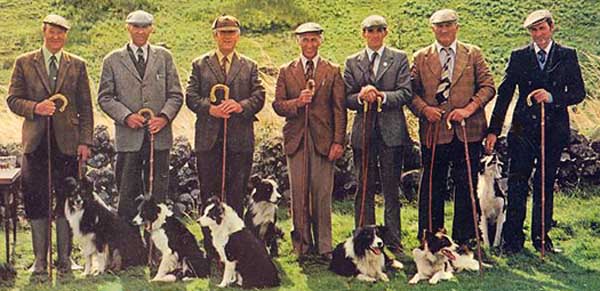
Sheepdog champions and their proud handlers at a trial at Glendevon.
I have the names (thanks to Barbara Carpenter and Dawn Bailey), but there seems to be some confusion over some of them,
so if you think any are wrong, and/or you know the dog's name where it is missing, please let me know (carole@woolgather.org).
They are, from left, Bob Dick and Sam; Willie Johnson and Cap; Christie Swan and Lynn; Jim Wannon and Tweed; Jim Veitch; David Russel or Watty Scott (?); and George Gardner and Fly.
February 20, 2012: I heard from George Gardner today (the gentleman on the far right) and he kindly filled me in about two others of these men, Jim Wannon and Jim Veitch. He told me that Fly, his dog in this photo, was in the National Team for three years in a row in the mid-eighties. My husband and I were at a trial at Glendevon some years ago, and we were impressed with the difficult trials field there, that was on a steep side of a hill. Mr. Gardner says that the "Glendevon trial has moved several times since then and is now in a large grass field."
THE INTERNATIONAL SHEEPDOG SOCIETY
The International Sheep Dog Society (ISDS) was formed in 1906 with the purpose to "improve the breed of the collie with a view to the better management of stock". Sometime after World War I, the term "Border Collie" was coined (attributed to James A. Reid, then secretary of the ISDS) to distinguish it from the show collie.
The ISDS is still the only registry of working sheepdogs in Britain and Ireland. Each year it puts on four prestigious National Sheep Dog Trials (the English, Irish, Scottish and Welsh), which determine the four teams that will compete in the International Sheep Dog Trials. It is the culmination of the trial year and only those that "make the teams" from the four countries of England, Scotland, Wales and Ireland are eligible to run in it. They represent the top winners of the National trials for each country, the creme de la creme in dogs and handlers. People flock from all over Britain and indeed the world to see this trial. Our own American sheepdog trials derive from British trials, but differ in subtle ways.
Barbara (Mrs. E. B.) Carpenter and her Border Collie, Chip, working sheep at the
pen.
THE INTERNATIONAL SHEEP DOG TRIALS:
What's It All About?
by Mrs. E. B. (Barbara) Carpenter, UK
Judging sheepdog trials is a very complex and often controversial affair. These notes briefly outlining the general system are designed to assist visitors to the trials, to understand something of the whys and wherefores involved; but only experience can lead to true assessment of the varied situations that can, and do, arise in the course of a run.
Each dog starts its course with a full set of points, judges deducting points as they deem appropriate and mistakes occur. Each phase of a run is individually pointed. Judges consider all relevant circumstances, e.g., the behaviour of the sheep and their reaction to their surroundings; and mark according to their knowledge of sheep and dog behaviour.
If a dog grips (or bites) a sheep, the judges confer together, and if they decide unanimously that the grip was unwarranted (e.g., loss of dog's temper) the dog will be disqualified. If not in agreement, each judge will then deduct points as he considers appropriate.
The dog should be in firm command of the sheep from the moment he "lifts" them, moving them with a quiet, smooth flowing "method". This method is an indefinable quality of work possessed by Border Collies to a greater or lesser degree, some seeming to calm and give confidence to the sheep they work.
Because sheep successfully negotiate the fetch and drive obstacles does not necessarily mean full points are gained. That depends also on straight lines from one obstacle to another, and any deviation from these straight lines is penalised. Sheep should ideally be moved around the course at a steady pace--stops and starts being penalised and any rash or slack work by the dog also losing points.
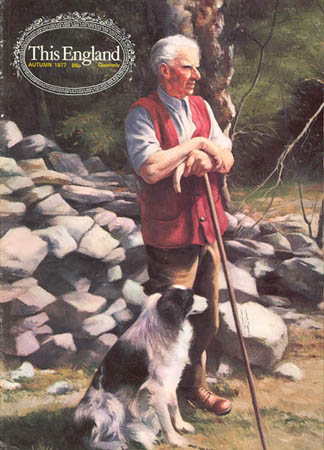 Left, shepherd Evan Hopkins and his dog poised for an outrun. This painting is from
the Autumn 1977 cover of This England magazine by the artist, John Edwards, from a
series of paintings he did especially for the magazine. Reproduced with kind permission from
This England magazine.
Left, shepherd Evan Hopkins and his dog poised for an outrun. This painting is from
the Autumn 1977 cover of This England magazine by the artist, John Edwards, from a
series of paintings he did especially for the magazine. Reproduced with kind permission from
This England magazine.
The Outrun
The outrun, to left or right as the handler chooses, should take the dog on an arc so that he arrives behind the sheep, at a little distance from them. A wide outrun allows the dog to encompass them within the arc of his run, cutting off their escape back to the holding pen. A dog running too close, or straight up the field to them will panic and scatter the sheep, and thus lose points. Equally wrong is too wide and outrun. Points are deducted if a dog crosses the course, thereby approaching his sheep on the opposite side from that which he started his outrun.
The perfect outrun needs no commands to re-direct the dog. If a dog stops, or has to be stopped for further commands, more points will be lost than if he obeys re-directions while continuing his outrun. A dog that stops and eyes the sheep before he has completed his outrun will lose points, as will a dog that over-runs the sheep and has to be commanded back behind them to commence the lift.
The Lift
The lift is very important. A run can be ruined by a sharp approach that unsettles the sheep. Having arrived behind the sheep at the point of balance where he can move them towards the handler, the dog should pause to allow them to become aware of, and accept his presence, and then walk firmly and steadily towards them, quietly moving them down the course in as direct a line as possible toward the handler. A slow, hesitant lift, or a rough one, or many commands to encourage the dog to lift the sheep, will be penalised.
The Fetch
Any deviation from a straight line on the fetch will lose points, and points are lost for each sheep missing the gates. The wider sheep stray from a straight line the greater the loss of points. A wide turn around the handler at the end of the fetch will lose points, as will also happen if the sheep are turned too sharply and veer inwards towards the centre of the course as the drive away begins.
The Drive
As in the fetch, straight lines from gate to gate are required in the drive, and tight turns around the drive hurdles to maintain the correct line across the course, and also from the second drive gate to the shedding ring. Points are lost for faults similar to those in the fetch.

This is Ernest Priestley of Derbyshire, and his dog Pat 4203 during their
winning run at the 1951 International Sheep Dog Trials at Blackpool, England. They are
attempting to shed in this photo (Photo
thanks to Mrs. E. B. Carpenter.)
The Shed
Sheep in the ring, the handler is allowed to leave the post, and endeavour to separate two unmarked sheep (i.e., two that do not wear red collar bands). The dog is called to assist, and hold--wear--these two sheep, showing that he is capable of taking them away from the others if it were necessary. The shed must be accomplished within the ring, with points lost if sheep pass out of it, although when the two sheep have been shed, the other three may go out of the ring without incurring loss of points. A handler doing too much of the work towards shedding, failure to shed when the opportunity occurs, failure of the dog to come in when asked, or failure to show control of shed sheep, all incur loss of points. The sheep should be re-gathered in the ring before the handler proceeds to the pen, leaving the dog to bring the sheep.
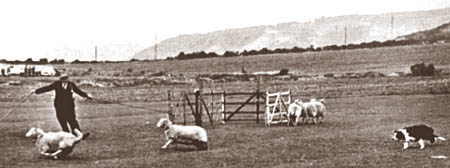
The dog in this photo is one of the famous Gilchrist's Spots at an International
Sheepdog Trial, date unknown. The caption reads "Not always so easy! When it comes to the
penning of five marked sheep the slightest error of judgement can prove fatal. James
Gilchrist and Spot are having a bit of trouble." Both Gilchrist brothers, James and John,
owned great dogs named Spot, the two most famous being Spot 3624 and Spot 24981 both
belonging to James. (Photo thanks to Mrs. E. B. Carpenter.)

Donald McLeod and Garry penning sheep during the Hired Shepherd's Competition at
the International Sheep Dog Trials in 1948. From 1919 to 1976 there were separate
classes for shepherds and farmers, the thought being that shepherds were at a
disadvantage to farmers because they did not own their own sheep and could not
practice the same way farmers could.
The Pen
Once holding the six foot rope attached to the pen gate, the handler must not let it go until penning is completed. He may assist the dog--it is a partnership--but the dog must do his fair share of the work, or points will be lost. Slack work, hesitant or rash work by the dog, will be penalised. Sheep being allowed to go round or part way around the pen, being allowed to mill about in the pen mouth, or break away, will incur loss of points. The gate must be closed on the penned sheep, and when they are released the handler must close and fasten it before proceeding to the shedding ring.
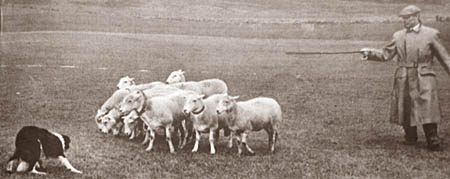
Welsh farmer W. J. Evans from Monmouthshire with his Border Collie Nell 6879
seen at the International Sheep Dog Trials in 1953 at Cardiff, Wales,
when they won the International Farmer' Championship
(Photo thanks to Mrs. E. B. Carpenter.)
The Single
The sheep taken back to the ring, one of the two sheep marked with red collar bands has to be separated--singled--the dog being called in to cut her out and hold her away from the others until the judges are satisfied of his ability to do so. A loss of points is incurred for similar faults as may occur in shedding.
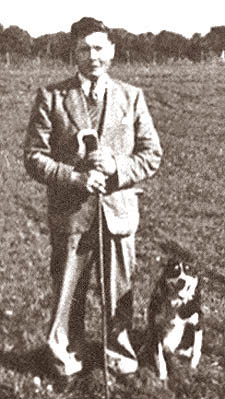 This is H. J. Worthington and Moss who won the Interntional Shepherd's Champion at the
International Sheep Dog Trials in both 1951 and 1953. (Photo thanks to Mrs. E. B.
Carpenter.)
This is H. J. Worthington and Moss who won the Interntional Shepherd's Champion at the
International Sheep Dog Trials in both 1951 and 1953. (Photo thanks to Mrs. E. B.
Carpenter.)
The Supreme Championship
On the final day of the International Sheepdog Trials, the Supreme Championship is competed for on an enlarged course. Two separate lots of sheep have to be gathered from different parts of the course and united enroute to the handler. Judging is similar to that in the Qualifying Trial, points being deducted for faults in both outruns, and for any faults attending the dog's turn back for the second lot of sheep. Should the first lot of sheep, which have to be left at a post below the fetch gate while the dog turns back for the others, stray away across the course, the dog has to be sent at the most convenient point to fetch them to re-join the others. Points will be lost if the second lot of sheep are driven off line to collect the straying sheep.
The shedding of five sheep marked with red collar bands from the flock of twenty has to be accomplished in the ring, the unmarked sheep run off between dog and handler and the dog holding the marked sheep always in the ring. Should any of these be allowed to leave the ring and join up with the unmarked shed sheep, all of them have to be regathered and the shedding begun again. Points are deducted for faults similar to shedding in the Qualifying Trial. The five marked sheep are penned, faults being penalised as stated previously.
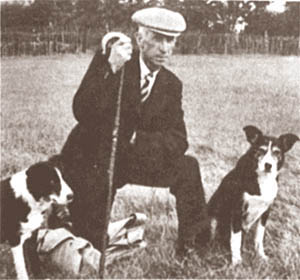 David Murray of Scotland with his three-time brace champions
Vic and Number. Murray won the International Brace Championship with
this pair in 1953, 1954 and 1955. We don't know which year this is.
(Photo thanks to Mrs. E. B. Carpenter.)
David Murray of Scotland with his three-time brace champions
Vic and Number. Murray won the International Brace Championship with
this pair in 1953, 1954 and 1955. We don't know which year this is.
(Photo thanks to Mrs. E. B. Carpenter.)
The Brace Competition
The brace competition is complicated by two dogs' work having to be assessed individually and also as a partnership with each other. Ideally, they should be working as a team. They are allowed to cross over behind the sheep at the end of their respective outruns, without loss of points, but if they change sides afterwards during the fetch or drive, points will be deducted. Similar faults occur during a brace run as in a singles run, and points similarly lost.
In the shedding ring, one dog is used to split the bunch of sheep in two equal lots. Usually this dog is left in charge of one lot, while the other dog takes the rest to the pen that has no gate. When safely penned, that dog is left on guard at the pen mouth to keep the sheep within, while the other dog pens his sheep in the pen that has a gate. Points are deducted for faults in penning at the individual pens, and also for any interference of either dog with the other's work; or if the dog left to guard the first pen leaves his position. Should these sheep escape from the pen before the second pen is completed, they have to be re-gathered and re-penned before the handler can attempt to pen the second lot of sheep.
We have photos taken at a number of sheepdog trials in Britain between 1978 and 1983.
We present them here just to give some idea of the variety of terrains in which sheepdog trials
in Britain are held.
For the most part, there is no commentary with them, and they are simply photo essays.
Photos taken by Carole or David Presberg.
[The thumbnails are the links.]
SHEEPDOG TRIALS IN BRITAIN AND IRELAND:
The 1983 International Sheepdog
Trials at Aberystwyth, Wales
SHEEPDOG TRIALS IN BRITAIN AND IRELAND:
A Local Sheepdog Trial at Essich, Invernesshire, Scotland, 1978
SHEEPDOG TRIALS IN BRITAIN AND IRELAND:
The 1986 Sheepdog Trial at Glendevon, Scotland
SHEEPDOG TRIALS IN BRITAIN AND IRELAND:
The 1986 Scottish National Sheepdog Trials at Eddleston, Scotland
See The Working Border Collie in America.
THE OTHER WEB PAGES WE MAINTAIN
These web pages are copyright ©2013
and maintained by webmeistress Carole Presberg
with technical help from webwizard David Presberg
ALL RIGHTS RESERVED
If you are interested in using ANY material on this website, you MUST first ask for permission.